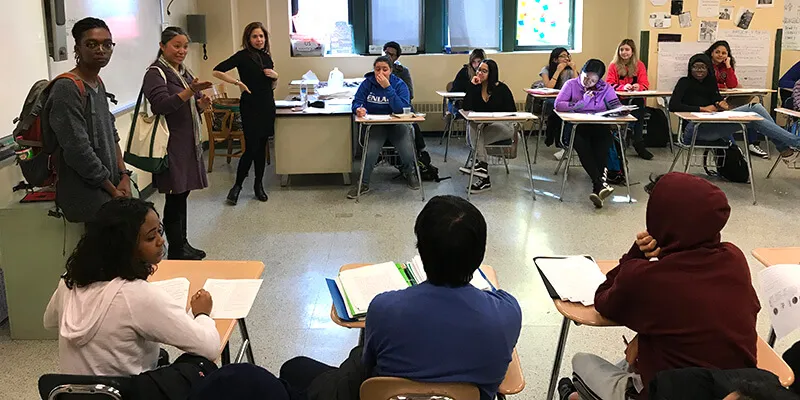Flore Costume ‘16 never imagined going to college in Vermont. But then, growing up in Brooklyn, Costume’s imagination was sparked in learning about global warming. “It felt huge and big, and I wasn’t hearing a lot about it,” says Costume, who decided to attend the High School for Environmental Studies (HSES) in Manhattan — and then, in a twist, the University of Vermont Rubenstein School of Environment and Natural Resources.
“A lot of my friends went during spring break for a campus tour, which encouraged me to think about considering UVM as a school,” says Costume, now working at UVM’s Sustainability Learning Community student residence. “It ended up being a good thing.”
A good thing indeed — not only for Costume, who has traveled to the Bahamas, Botswana and beyond to study and share sustainability concepts in community development — but also for the continued partnership between UVM’s Rubenstein School and HSES.
The two schools initially connected in the 1990s, as UVM’s Dean Don DeHayes sought greater diversity for the Rubenstein School. The effort, which soon grew into a formal partnership, dovetailed fortuitously with funding from the U.S. Department of Agriculture in the form of Multicultural Scholar grants for students, many of them HSES graduates, to attend the Rubenstein School. Forty-six USDA Multicultural Scholarships have been awarded to Rubenstein School students, including four this 2017-18 academic year.
In 2006, the Donald H. DeHayes Multicultural Scholarship was created to honor the former dean's leadership and passion for fostering diversity in the School. This scholarship, the USDA grant program, and the partnership with HSES are overseen by Marie Vea-Fagnant, Assistant Dean for Student Services and Staff Development, and Walter Poleman, Senior Lecturer and Chair of the Rubenstein School Core Curriculum Committee.
“This is an attempt to deepen the relationship between the Rubenstein School and high schools in New York,” says Poleman, who teaches an introductory class to 180 first-year Rubenstein School students. “We’re now making it even more robust and vital so that we are successful in recruiting students, and in retaining them for a high-quality experience. I’m interested in reciprocity — some of our students are studying there, and students and teachers from New York City are coming to Vermont, as well.”
Last spring Poleman and Vea-Fagnant visited HSES along with the New York Harbor School in Brooklyn and the Rocking the Boat program in the South Bronx. The trip was followed by an invitation to the HSES principal to attend Education for Sustainability learning sessions at Shelburne Farms in Vermont. Then, this past December 2017, Costume joined Poleman and Vea-Fagnant for another trip to HSES, sharing information on UVM and also showcasing the ongoing UVM Spatial Analysis Laboratory research program overseen by Jarlath O’Neil Dunne, involving urban tree canopy assessments.
“It’s really cool — we’re training teachers and students to get on the ground and take pictures, to triangulate,” says Vea-Fagnant, who is also working on coordinating with The Nature Conservancy for career programs. “Students have become leaders and joined great organizations because of this partnership.”
Next up? A return by Poleman with first-year students to New York City in spring 2018 and then 12 to 14 HSES faculty members coming to Shelburne Farms in July for a specialized workshop. All told, more than $2.5 million in USDA grants is paying off in big ways. Says Poleman, “We definitely have a trajectory going forward. These priorities are a part of the core mission of the Rubenstein School.”
